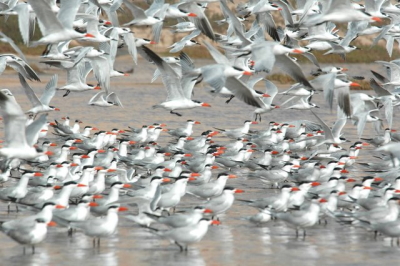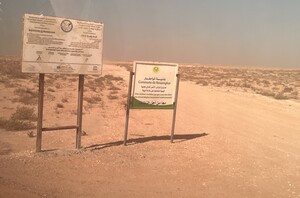Banc d'Arguin

Banc d'Arguin National Park is renowned for its many nesting and migrating birds.
The park covers a rich marine and coastal ecosystem between the Sahara and the Atlantic Ocean. Its mudflats and sandbanks provide resting places for over two million migrant shorebirds from northern Europe, Siberia, and Greenland. Due to the permanent upwelling off Cap Blanc, the surrounding waters are some of the richest fishing waters in western Africa.
Community Perspective: it’s a huge park but the general bird-viewing conditions seem disappointing. Solivagant describes his visit in March 2007, which included a 4x4 seashore drive and a boat ride. Els visited in late 2024 and especially enjoyed the offshore sandbanks that look like floating icebergs.
Map of Banc d'Arguin
Community Reviews
Els Slots

Mauritania’s Banc d’Arguin NP is rarely visited and has only been reviewed once, about 18 years ago. However, this is the number one place for waterfowl and migratory waders among the several "bird WHS" along the West African Coast. It is “better” than Djoudj and the Saloum Delta, and only the 2025 nomination Bijagos Archipelago in Guinea-Bissau comes close but still has only 50% of its numbers. We spent a full day and a night in its core zone, stretching 170km along the Atlantic Coast.
The Banc d’Arguin is so rich because it lies next to an ocean upwelling that produces nutrient-rich cooler waters. This sets a whole food chain of phytoplankton-filter feeders-fish-birds-marine mammals in motion.
We approached it from the South, driving for 2.5 hours from the capital Nouakchott. This is mostly a good paved road, where our drivers even clocked 130km/h. The surrounding landscape is rather featureless, though you will see some dromedaries roaming around. We made a first stop at Mamghar, one of the seven fishing villages inside the park. The smell of fish is predominant here: the people leave their gutted fish drying out on the fences surrounding the corrals for the goats.
On the outskirts of town, you can walk onto the seabank and observe bird colonies that have found their nesting or resting spot right there. We saw two sandbanks right offshore fully covered by a variety of bird species, including larger ones such as pelicans. A bit more inland, there are lakes surrounded by green bushes (a rare sight here in the desert) and there even is a bird hide. It was a fine short visit, but when you’re a serious birder, you really need to allocate more time to this park – you can go on full-day boat trips to sand banks further away.
After an hour we drove North, taking the great beach road and sometimes diverting a bit into the dunes. It’s very windy along the coast and the weather has created shell middens and finely carved sand dunes.
We overnighted in a permanent camp near Iwik, which is run by a local cooperative. The living conditions in this fishing village built out of shipping containers and wooden sheds look very tough, as it gets very hot out here and there are hardly any amenities. We could admire the works of the fishermen though, preparing their tall wooden sailing ships for another morning at sea.
The next day we drove another 1.5 hours North through the park. In this area, you can clearly see the offshore sandbanks – they look a bit like icebergs floating by in the ocean (see photo 3, the white bit in the distance); to me, it’s the most characteristic image of this WHS.
We also visited Cap Blanc, about 4 hours from Iwik, which is labelled in the official documentation and at its visitor centre as a ‘satellite site’ to Banc d’Arguin NP, but has been excluded from the final inscription on the instigation of IUCN because of border issues. It comprises the Mauritanian part of the peninsula that protrudes into the ocean from the city of Nouadhibou. You need to pass through the very busy port area, where the infamous Iron Ore Train arrives. Just on the tip, there’s a nature reserve, not much more than a small but pretty beach. Its pride was the colony of rare monk seals, but they all - except for 1 or 2 that still come by occasionally - have migrated to the Western Saharan side of the peninsula as it is much quieter over there.
Read more from Els Slots here.
Solivagant

The global significance of Banc d’Arguin is incontrovertible – “Of the estimated seven million wading birds which use the Atlantic flyway, approximately 30% spends the winter at Banc d'Arguin, which hosts the largest concentration of wintering waders and one of the most diversified communities of nesting piscivorous birds in the world.” However, like most “wetland” WHS, it is primarily a destination for ornithologists who can give it the right amount of time and expertise at the optimum season of the year.
The Park is huge and stretches along c30% of Mauritania’s coast. Its designated area is about 50% maritime and 50% land and a 4x4 vehicle is essential for the latter. The nearest asphalt is at the Chami entrance at approximately the mid point N-S. From there it is 30kms across sandy and often unclear tracks to the fishing village of Iwik which is the main place for hiring the boat necessary to reach the “banks” themselves where the main birding areas are. Any attempt to go north or south from Iwik can take you on tracks leading into dunes or areas inundated at high tides and having treacherous crusted surfaces. Our local driver drove these to the southern exit at Mamghar in order for us to see the Cape Timrit area. From there we had hoped to take the “classic” c170 kms “low tide” sea shore drive to Nouakchott but the tide times were not convenient and we had to “force” a route east out of the Park through dunes and across “virgin desert” to the asphalt road – this occasioned a rather surreal meeting with a passing camel herder to “ask the way”! He suggested a few degrees alteration to our “dead reckoning” bearing and was rewarded with a few cups of water before striding into the emptiness with only his camels (and no more water)!
Entrance to the park in 2007 was 2400 Ouguiya per person (c $10 US) for 2 days, but the biggest expense is going to be the boat rental at Ou 20000 for a day’s boat hire – shareable with up to around 7 if there are any other tourists (we were alone)! Depending on his mood on the day, you might also have to pay Ou 3000 for the “obligatory” park guide to accompany you. We avoided this as he had “better” things to do! Whether his presence would have added anything useful I doubt – the boatmen are well aware of what is where and of the restrictions regarding access (which are significant – and even more so at nesting time). His presence would also prevent you from using a video camera during the boat trip. They are paranoid about this – a reasonable concern for “professional” equipment which should pay extra, but OTT for a small “hand-held” being used for “souvenir” purposes and certainly incapable of recording birds in any quality. However they seem unaware that the better modern digital cameras can take very acceptable video!
We visited the park in early March knowing that this wasn’t the best time for “bird volumes” (November is optimum?) but were nevertheless a bit disappointed with the quality of what we saw and the general viewing conditions. A few days later we went south to the Senegal River (Diawling NP in the same ecosystem as Djoudj WHS and just across the bordrer from it - another “near miss” unfortunately!!) and easily saw most of the species from Banc d’Arguin (albeit at lower volumes) plus a large number of additional land and riverine birds. The camps at Iwik are not very good either, with a choice of 2, both of which are bleak, very hot and unappealing – the better option of a bivouac in the desert may not be allowed in the park? There are no hotels or guest houses.
1000 or so Imraguen people live in the park, subsisting by fishing. They will crew one of their boats to take you to the banks. Mauritania tried to get their activities included within the inscription as a “cultural dimension” but IUCN rejected this – however their life style and the impact of the park and the outside world on it are interesting aspects to consider during a visit. A major activity in season is fishing for Mullet and the production of “Bottarga” (cured roe) – an expensive gourmet delicacy in Mediterranan countries. They are the only people allowed to fish in the park, and then must only use traditional boats and techniques. This involves the symbiotic assistance of dolphins, summoned by splashing the water around the boat, so driving the mullet into nets. We experienced the “summoning” during our boat trip but it wasn’t the mullet season and indeed we could buy no fish of any kind at Iwik for our own meals! Whether this reflects the impact of the undoubted over-fishing in the area by Japan, Spain and other nations I know not
I have found it difficult to find an appropriate photo of the Park! That (top) of the whale skeleton next to the park office sign at Iwik is there “for the record”. Beyond that I could use a picture of Flamingos or Pelicans – but you can find much better on the Web taken with specialist equipment. Photos of the mud flats and desert do not really provide a statement which could be “unique” to Banc d’Arguin. I have chosen therefore a photo (bottom) of “The approach to Iwik by sea in a sandstorm”! To me it captures place, time and mood!! It may be great for birds but this is a harsh environment for humans – you may question whether a visit is worth the effort!
Community Rating
Site Info
- Full Name
- Banc d'Arguin National Park
- Unesco ID
- 506
- Country
- Mauritania
- Inscribed
- 1989
- Type
- Natural
- Criteria
-
9 10
- Categories
- Wildlife habitat - Fauna
- Link
- By ID
Site History
1989 Inscribed
Site Links
Connections
The site has 30 connections
Ecology
Geography
History
Human Activity
Timeline
Trivia
WHS on Other Lists
World Heritage Process
Visitors
24 Community Members have visited.
The Plaque
 (photo by Els)
(photo by Els) (photo by Els)
(photo by Els)